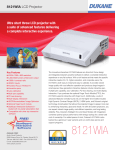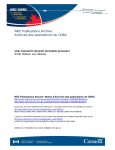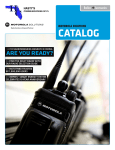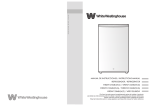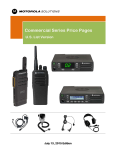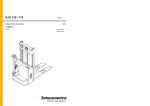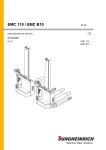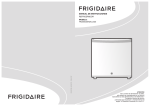Download Raymarine ST60 Specifications
Transcript
81039_4.book Page i Wednesday, March 24, 2004 3:14 PM ST60 Multi Instrument Owner’s Handbook Document number: 81039-4 Date: 1 April 2004 81039_4.book Page ii Wednesday, March 24, 2004 3:14 PM Raymarine, ST60 and SeaTalk are trademarks of Raymarine Limited © Handbook contents copyright Raymarine Limited 2004 81039_4.book Page i Wednesday, March 24, 2004 3:14 PM Preface i Preface Important information Safety notices WARNING: Product installation & operation This equipment must be installed and operated in accordance with the Raymarine instructions provided. Failure to do so could result in personal injury, damage to your boat and/or poor product performance. WARNING: Electrical safety Make sure you have switched off the power supply before you start installing this product. WARNING: Although we have designed this product to be accurate and reliable, many factors can affect its performance. Therefore, it should serve only as an aid to navigation and should never replace commonsense and navigational judgement. Always maintain a permanent watch so you can respond to situations as they develop. EMC conformance All Raymarine equipment and accessories are designed to the best industry standards for use in the recreational marine environment. The design and manufacture of Raymarine equipment and accessories conform to the appropriate Electromagnetic Compatibility (EMC) standards, but correct installation is required to ensure that performance is not compromised. Handbook information To the best of our knowledge, the information in this handbook was correct when it went to press. However, Raymarine cannot accept liability for any inaccuracies or omissions it may contain. In addition, our policy of continuous product improvement may change specifications without notice. Therefore, Raymarine cannot accept liability for any differences between the product and the handbook. 81039_4.book Page ii Wednesday, March 24, 2004 3:14 PM ii ST60 Multi Instrument Owner’s Handbook 81039_4.book Page iii Wednesday, March 24, 2004 3:14 PM Preface iii Contents Preface ......................................................................................................................i Important information ..................................................................................... i Safety notices .......................................................................................... i EMC conformance ................................................................................... i Handbook information ............................................................................ i Contents................................................................................................... iii Introduction ...................................................................................................vii Data inputs ....................................................................................................vii Remote control .............................................................................................viii Options .........................................................................................................viii Auxiliary alarm .....................................................................................viii Mounting options ................................................................................viii Parts supplied ...............................................................................................viii Chapter 1: Operation ............................................................................................1 1.1 Introduction ........................................................................................... 1 1.2 Normal operation ................................................................................... 1 Finding the information you want .......................................................... 1 1.3 Chapters and pages ............................................................................... 4 Depth chapter pages .............................................................................. 4 Speed chapter pages .............................................................................. 4 Wind chapter pages ............................................................................... 5 Heading chapter pages .......................................................................... 5 Navigate chapter pages ......................................................................... 6 Environment chapter pages ................................................................... 6 Autopilot chapter pages ......................................................................... 7 1.4 Using the track key ................................................................................. 7 1.5 Alarms .................................................................................................... 7 Internal alarms ....................................................................................... 7 Auxiliary Alarm option ........................................................................... 8 1.6 Operating with NMEA ............................................................................ 8 SeaTalk to NMEA 0183 ........................................................................... 8 NMEA to SeaTalk .................................................................................... 9 1.7 Display settings ...................................................................................... 9 Illumination ............................................................................................ 9 Contrast ............................................................................................... 10 1.8 Pop-up Pilot .......................................................................................... 10 1.9 Remote control .................................................................................... 10 81039_4.book Page iv Wednesday, March 24, 2004 3:14 PM iv ST60 Multi Instrument Owner’s Handbook Chapter 2: Maintenance & Troubleshooting ..................................................11 2.1 Maintenance ........................................................................................11 Servicing and safety ..............................................................................11 Instrument ............................................................................................11 Transducer ............................................................................................11 Cabling .................................................................................................12 2.2 Troubleshooting ...................................................................................12 Preliminary procedures .........................................................................12 Fixing faults ..........................................................................................12 Technical support ..................................................................................13 World wide web .............................................................................13 Telephone help line ........................................................................13 Help us to help you .........................................................................13 Chapter 3: Installation .......................................................................................15 3.1 Planning your installation .....................................................................15 Site requirements .................................................................................15 EMC installation guidelines ..................................................................16 Suppression ferrites ........................................................................17 Connections to other equipment ....................................................17 3.2 Procedures ...........................................................................................17 Unpacking ............................................................................................17 Fitting the instrument ...........................................................................18 Surface mounting ...........................................................................18 Flush mounting ..............................................................................19 Fitting the low-profile bezel ......................................................19 Flush mounting procedure .......................................................20 Bracket mounting ...........................................................................21 Auxiliary alarm option ..........................................................................22 Connecting the instrument ...................................................................23 Types of connection ........................................................................23 Connection options ........................................................................23 Signal connections .........................................................................23 Power supply connections ..............................................................25 Chapter 4: Calibration ........................................................................................27 4.1 Introduction ..........................................................................................27 EMC conformance ................................................................................27 4.2 User calibration ....................................................................................27 Procedure .............................................................................................28 Chapter titles ..................................................................................28 Heading type ..................................................................................28 Battery alarm threshold ..................................................................28 Alarms on/off .................................................................................28 81039_4.book Page v Wednesday, March 24, 2004 3:14 PM Preface v Date format .................................................................................... 28 Time format ................................................................................... 28 Time offset ..................................................................................... 30 Units setup ..................................................................................... 31 Setting units ............................................................................. 31 Waypoint identity ........................................................................... 31 Select NMEA or auxiliary alarm ...................................................... 31 Auxiliary alarm enable ................................................................... 31 Pop-up pilot ................................................................................... 32 Instrument configuration ............................................................... 32 Leaving User calibration ....................................................................... 34 4.3 Intermediate calibration ....................................................................... 34 4.4 Dealer calibration ................................................................................. 35 User calibration on/off ......................................................................... 35 Response settings ................................................................................ 35 Factory defaults .................................................................................... 37 Leaving Dealer calibration .................................................................... 37 81039_4.book Page vi Wednesday, March 24, 2004 3:14 PM vi ST60 Multi Instrument Owner’s Handbook 81039_4.book Page vii Wednesday, March 24, 2004 3:14 PM Preface vii Introduction Thank you for purchasing a Raymarine product. We are sure your ST60 instrument will give you many years of trouble-free operation. This handbook describes how to install and use the Raymarine ST60 Multi instrument. This instrument provides a wide range of accurate depth information, on a high quality Liquid Crystal Display (LCD). The instrument is constructed in a rugged weather-proofed case to provide reliable performance, even under the most demanding conditions. 23-2 D43 Data inputs SeaTalk enables a number of compatible instruments to operate as a single, integrated navigational system. Instruments in a SeaTalk system are linked by means of a single cable, which feeds both power and data. Instruments can therefore be added to the system by plugging them into the network. SeaTalk is flexible enough to adapt to any number of compatible instruments without requiring a central processor. When connected to SeaTalk, the ST60 Multi instrument repeats information provided by other equipment in the SeaTalk network. The ST60 Multi instrument can also provide data communication between the internationally-accepted National Marine Electronics Association (NMEA) systems and SeaTalk. 81039_4.book Page viii Wednesday, March 24, 2004 3:14 PM viii ST60 Multi Instrument Owner’s Handbook Remote control When connected to SeaTalk, the ST60 Multi instrument can be controlled remotely by a SeaTalk Remote Keypad Unit, to provide instant remote access to the various display readouts. Options Auxiliary alarm An Auxiliary Alarm (Raymarine Part No. Z035)can be connected to the ST60 Multi instrument and set to respond to various system alarms. This provides an additional audible alarm at a much higher volume than the internal alarm. Mounting options If you do not want to surface mount your ST60 instrument, options are available for: • Flush mounting. If you have ordered the flush mounting option a low-profile bezel and four fixing screws are provided. • Bracket mounting. Parts supplied Unpack your ST60 instrument and check that the following items are present: • Item 1,ST60 Multi instrument fitted with standard bezel for surface mounting. • Item 2,Fixing studs (2). • Item 3,Thumb nuts (2). • Item 4,Gasket. • Item 5,SeaTalk interconnection cable. • Item 6,Instrument Cover. • Item 7,Owner’s Handbook. A Warranty document and fitting templates are included in this Handbook. • Item 8,Cue Card. Spare spade terminals are also provided. 81039_4.book Page ix Wednesday, March 24, 2004 3:14 PM Preface ix 1 4 2 3 2 3 5 6 MULTI ST60 Multi Instrument Owner's Handbook Operation Key: Chapter selection and content 7 8 D4440-3 81039_4.book Page x Wednesday, March 24, 2004 3:14 PM x ST60 Multi Instrument Owner’s Handbook 81039_4.book Page 1 Wednesday, March 24, 2004 3:14 PM Chapter 1: Operation 1 Chapter 1: Operation 1.1 Introduction This handbook describes how to operate, maintain and install the Raymarine ST60 Multi instrument. CAUTION: Calibration requirement The ST60 Multi instrument is calibrated to factory (default) settings when first supplied. To ensure optimum performance on your boat, this product must be calibrated before use. Do NOT use the product until it has been calibrated using the procedures in Chapter 4, Calibration. 1.2 Normal operation The information displayed on the ST60 Multi instrument is organized in groups or ‘chapters’, and within each chapter, the different types of information are presented as pages. The availability of pages on your ST60 Multi instrument depends on: • What information is available from SeaTalk. This handbook assumes all data sources are available. • Which pages are enabled during Instrument configuration (see Chapter 4, Calibration ). This handbook assumes all pages are enabled. Finding the information you want The disposition of the ST60 Multi chapters and pages, is shown in the Chapter selection and content illustration, below. This illustration assumes a system where all information sources are available. 81039_4.book Page 2 Wednesday, March 24, 2004 3:14 PM 2 ST60 Multi Instrument Owner’s Handbook Depth Current depth Minimum depth Maximum depth Speed Autopilot Speed Maximum speed Average speed Speed over ground VMG to windward Log Trip Timer Pilot status Rudder angle Key: Chapter name Pages within chapter Listed in sequence. Accessed with key. Wind Apparent wind speed Apparent wind angle True wind speed True wind angle (sailing) True wind direction Beaufort and cardinal Notes: 1. If chapter titles are enabled during calibration, the name of the selected chapter is displayed for 2 seconds after the key is pressed, after which time, the first page in the selected chapter is displayed. Environment Water temperature Battery voltage Time Date 2. You can switch off any unwanted chapter or page, to reduce the amount of information displayed (see Chapter 4, Calibration ). Heading Navigate Navigate Current heading Locked heading Heading on next track Course over ground Course made good Distance made good Bearing to waypoint Distance to waypoint Cross track error Waypoint number/name Latitude Longitude Course over ground Speed over ground Satellites tracked Chapter selection and content D4409-1 81039_4.book Page 3 Wednesday, March 24, 2004 3:14 PM Chapter 1: Operation 3 To display a particular page: 1. Refer to the Chapter selection and content diagram to determine the location of the information you need (i.e. which chapter it is in), then press the key the necessary number of times, to cycle to the required chapter. If the chapter title facility is enabled (see Chapter 4, Calibration ), the name of each chapter is briefly displayed when it is first selected. Note: Although most chapter names are displayed in full, the Environment chapter is abbreviated to ENVIRO and the Autopilot chapter is abbreviated to PILOT . 2. With the appropriate chapter selected, use the page. key to select the required The manner in which information is accessed is illustrated in the following example, which shows how to display true wind speed information. Selecting chapter Selecting page Either press or wait for 2 second time out How to select a page D4405_1 81039_4.book Page 4 Wednesday, March 24, 2004 3:14 PM 4 ST60 Multi Instrument Owner’s Handbook 1.3 Chapters and pages This section lists all the available pages along with titles and salient points. Depth chapter pages Function Title Remarks Current depth - Displayed in either FEET , METRES or FATHOMS . An up arrow is displayed if the sea-bed is rising, and a down arrow is displayed for sea-bed falling. If the depth echo is lost, the last valid depth reading is shown and LAST flashes. Minimum depth MIN Minimum depth since power up or last reset, in feet (FT) meters (M) or fathoms (FA). Press the reset key for 3 seconds, to reset. Maximum depth MAX Maximum depth since power up or last reset, in feet (FT) meters (M) or fathoms (FA). Press the reset key for 3 seconds, to reset. Speed chapter pages Function Title Remarks Boat speed BOAT Displayed in kilometers per hour (KMH), miles per hour (MPH), or knots (KTS). Maximum speed MAX Maximum speed since power up or last reset, in kilometers per hour (KMH), miles per hour (MPH), or knots (KTS). Press the reset key for 3 seconds, to reset. Average speed AVG Average speed since power up or last reset, in kilometers per hour (KMH), miles per hour (MPH), or knots (KTS). Speed over ground SOG Displayed in kilometers per hour (KMH), miles per hour (MPH), or knots (KTS). Velocity made good VMG Displayed in kilometers per hour (KMH), miles per hour (MPH), or knots (KTS). Log LOG Total distance covered since the system was installed, in kilometers (KM), statute miles (SM), or nautical miles (NM). Trip TRIP Distance covered since power up or last reset, in kilometers (KM), statute miles (SM), or nautical miles (NM). Count up timer TIMER Shows current count-up time in either seconds (S), minutes (M) or hours (H). Count-down timer RACE Shows time remaining to zero in seconds (S) or minutes (M). START 81039_4.book Page 5 Wednesday, March 24, 2004 3:14 PM Chapter 1: Operation 5 Wind chapter pages Function Title Remarks Apparent wind speed APP Either knots (KTS) or meters per second (M/S). Apparent wind angle APP Shown in degrees. Shows a STBD indicator when the boat is on a starboard tack and a PORT indicator when the boat is on a port tack. True wind speed TRUE Either knots (KTS) or meters per second (M/S). True wind angle TRU Shown in degrees. Shows a PORT indicator when the boat is on a starboard tack and a STBD indicator when the boat is on a port tack. True wind direction WIND Shown in degrees. Shows either a MAG(netic) or TRU(e) indicator, depending on the selected bearing type. Beaufort and cardinal BFT Shows the wind speed Beaufort scale value and wind direction as a cardinal compass point. Heading chapter pages Function Title Remarks Current head- HDG ing Displayed in degrees. Either TRU(e) or MAG(netic) depending on the value set during User calibration (see Chapter 4, Calibration ). Locked heading LOCK Shown in degrees. When the locked heading is controlled by an autopilot or when a Steering Compass is locked on, the legend AUTO is displayed. Next tack TACK Shown in degrees. Course over ground COG Shown in degrees. Either TRU(e) or MAG(netic) depending on the value set during User calibration (see Chapter 4, Calibration ). Course made good CMG Shown in degrees. Either TRU(e) or MAG(netic) depending on the value set during User calibration (see Chapter 4, Calibration ). Press the reset key for 3 seconds, to reset. Distance made good DMG Shown in either kilometers (KM), statute miles (SM), or nautical miles (NM). Press the reset key for 3 seconds, to reset. 81039_4.book Page 6 Wednesday, March 24, 2004 3:14 PM 6 ST60 Multi Instrument Owner’s Handbook Navigate chapter pages Function Title Remarks Bearing to waypoint BTW Displayed in degrees. Either TRU(e) or MAG(netic) depending on the value set during User calibration (see Chapter 4, Calibration ). Distance to way- TW point In kilometers (KM), statue miles (SM), or nautical miles (NM) Cross track error XTE Shown in the currently selected distance units. A steering bar at the top of the screen comprises arrows that show the direction to steer. Each arrow represents 0.05 nm of error, i.e. the number of arrows in the bar is proportional to the amount of cross track error. Waypoint see number/name WP Number or name displayed, depending on the choice made in User calibration (see Chapter 4, Calibration ). Cross track error (XTE) is shown by the large characters. Latitude LAT Current latitude. Longitude LON Current longitude. Course over ground COG Shown in degrees. Either TRU(e) or MAG(netic), as set during User calibration (see Chapter 4, Calibration ). Speed over SOG Displayed in kilometers per hour (KMH), miles per hour (MPH), or knots (KTS). Satellites tracked SATS Current satellite count. Environment chapter pages Function Title Remarks Water tempera- WATER Displayed as either °C or °F. ture Battery voltage VOLTS Supply voltage. Time- - Either 12- or 24-hour clock, as set during User calibration (see Chapter 4, Calibration ). Date - Either USA or European format, as set during User calibration (see Chapter 4, Calibration ). 81039_4.book Page 7 Wednesday, March 24, 2004 3:14 PM Chapter 1: Operation 7 Autopilot chapter pages Function Title Remarks Pilot status - Same function as pop up pilot display, but does not time out. Rudder angle RUDDER In degrees either P(ort) or S(tarboard). 1.4 Using the track key If your system includes a SeaTalk autopilot working in conjunction with a track plotter, you can operate the track plotter in track mode, as follows: 1. Press the track key once, so the track plotter enters track mode. 2. In track mode to plot a track to the next waypoint, press the track key for 1 second. 3. To leave track mode, press the track key again. 1.5 Alarms Internal alarms The ST60 Multi instrument responds to alarm signals by sounding an internal buzzer and by flashing the appropriate alarm message at the top of the screen alternately with the normal top line of the current display. The alarm messages are as follows: Message Meaning SHALLOW Shallow water. See Note below. DEEP ALM Deep water. See Note below. ANCHOR Deep or shallow anchor. See Note below. WIND ALM Wind speed. See Note below. LOW VOLT The power supply voltage has fallen below the low voltage threshold GUARD Radar alarm MARPA Radar alarm RAD FAIL Radar alarm 81039_4.book Page 8 Wednesday, March 24, 2004 3:14 PM 8 ST60 Multi Instrument Owner’s Handbook Note: If a depth alarm occurs while a page in the depth chapter is displayed, or a wind alarm occurs while a page in the wind chapter is displayed, the screen will revert to the first page of the respective chapter. To cancel an alarm, press any one of the ST60 Multi front panel keys. Auxiliary Alarm option An optional Auxiliary Alarm can be fitted at a convenient remote position, to give a loud, audible indication if any one of a range of alarms occurs. This option is particularly useful for situations where high ambient noise may make it difficult to hear the instrument’s internal alarm (e.g. aboard a power boat). The range of alarms sounded by the Auxiliary Alarm depends on: • What data is available on SeaTalk. • Which alarms are enabled during User calibration (see Chapter 4, Calibration ). If the Auxiliary Alarm sounds, check your instruments to see which one is showing an alarm indication, and take the appropriate action. Note: An Auxiliary Alarm cannot be fitted if the NMEA output port is being used. 1.6 Operating with NMEA The ST60 Multi instrument can provide data communication between SeaTalk and NMEA when the appropriate connections are made, and supports NMEA 0183 compatible products. SeaTalk to NMEA 0183 Data from SeaTalk is transmitted to the NMEA output port every 2 seconds. The data types and NMEA headers are: Data NMEA Header Depth DBT Heading, deviation and variation HDG Magnetic heading HDM Water temperature MTW Water speed and heading VHW Wind speed and angle MWV 81039_4.book Page 9 Wednesday, March 24, 2004 3:14 PM Chapter 1: Operation 9 NMEA to SeaTalk The ST60 Multi instrument decodes certain data from NMEA when available, and if the respective data is not already present on SeaTalk, transmits the decoded data to SeaTalk. The data types and NMEA headers are: Data NMEA Header XTE, Waypoint identifier, Bearing & distance to waypoint APB Bearing & distance to waypoint BWC Bearing & distance to waypoint rhumb line BWR Latitude and longitude GLL Time, latitude, longitude, satellites tracked & HDOP GGA Cross track error MWV or XTE Navigational information RMB Time, date, lat, long, COG & SOG RMC COG and SOG VTG 1.7 Display settings Illumination When the instrument is first powered up, the display illumination is set to its lowest (courtesy) level, to facilitate initial access to the keys. To adjust the level of display illumination: 1. Hold down the key for approximately one second, to enter the illumination-adjust mode. 2. There are four preset illumination levels. Momentarily press the cycle through these levels until you reach the level you want. 3. Press any other key to leave the illumination-adjust mode. key to Note: The display will also return to normal operation 7 seconds after the last key press. 81039_4.book Page 10 Wednesday, March 24, 2004 3:14 PM 10 ST60 Multi Instrument Owner’s Handbook Contrast To adjust the display contrast: 1. Hold down the adjust mode. key for approximately two seconds, to enter the contrast- 2. There are four preset contrast settings. Momentarily press the key to cycle through these settings until you achieve optimum display quality. 3. Press any other key to leave the contrast-adjust mode. Note: The display will also return to normal operation 7 seconds after the last key press. 1.8 Pop-up Pilot A Pop-up Pilot facility enables instruments connected to SeaTalk to constantly monitor any changes to the autopilot mode and to the course settings. If one of these parameters changes, the new value is immediately displayed on the ST60 instrument for 5 seconds, after which time the display reverts to the previous display. This facility can be enabled or disabled during User calibration (see Chapter 4, Calibration ). 1.9 Remote control When it is connected to SeaTalk, the ST60 Multi instrument can be controlled remotely with a SeaTalk Remote Keypad Unit. Remote control of an instrument is indicated by a REMOTE legend on the display, to indicate that the keypad has control. Details on how to use the remote control facility can be found in the SeaTalk Remote Keypad Owner’s Handbook. 81039_4.book Page 11 Wednesday, March 24, 2004 3:14 PM Chapter 2: Maintenance & Troubleshooting 11 Chapter 2: Maintenance & Troubleshooting 2.1 Maintenance Servicing and safety • Raymarine equipment should be serviced only by authorised Raymarine service technicians. They will ensure that servicing procedures and replacement parts used will not affect performance. There are no user-serviceable parts in any Raymarine product. • Some products generate high voltages, and so never handle the cables/connectors when power is being applied to the equipment. • When powered up, all electrical equipment produces electromagnetic fields. These can cause adjacent pieces of electrical equipment to interact with one another, with a consequent adverse effect on operation. In order to minimize these effects and enable you to get the best possible performance from your Raymarine equipment, guidelines are given in the installation instructions, to enable you to ensure minimum interaction between different items of equipment, i.e. ensure optimum Electromagnetic Compatibility (EMC). • Always report any EMC-related problem to your nearest Raymarine dealer. We use such information to improve our quality standards. • In some installations, it may not be possible to prevent the equipment from being affected by external influences. In general this will not damage the equipment but it can lead to spurious resetting action, or momentarily may result in faulty operation. Instrument Certain atmospheric conditions may cause condensation to form on the instrument window. This will not harm the instrument and can be cleared by increasing the illumination setting to Level 3. Periodically clean your ST60 instrument with a soft damp cloth. Do NOT use chemical and abrasive materials to clean the instrument. Transducer Refer to the Installation and Maintenance instructions supplied with the transducer. 81039_4.book Page 12 Wednesday, March 24, 2004 3:14 PM 12 ST60 Multi Instrument Owner’s Handbook Cabling Examine all cables for chafing or other damage to the outer shield and, where necessary, replace and re-secure. 2.2 Troubleshooting Preliminary procedures Changes in the electronic environment may adversely affect the operation of your ST60 equipment. Typical examples of such changes are: • Electrical equipment has recently been installed or moved aboard your vessel. • You are in the vicinity of another vessel or shore station emitting radio signals. If you appear to have a problem, first ensure that the EMC requirements are still being met before further investigating the problem. Fixing faults Some data types may not be supported by your system and therefore will not be displayed on your ST60 Multi instrument. If you think that some data is missing, ensure that your system supports this data before assuming that a fault exists. All Raymarine products are subjected to comprehensive test and quality assurance programmes prior to packing and shipping. However, if a fault occurs, the following table may help to identify and rectify the problem. Fault Cause Remedy Display blank No power supply Check power supply. Check SeaTalk cabling and connector security Check fuse/circuit breaker No transfer of information between SeaTalk instruments (e.g. illumination levels). SeaTalk cable or connector fault Failure of a group of SeaTalk instruments. SeaTalk cable or connector fault Check securi























































